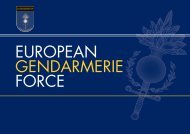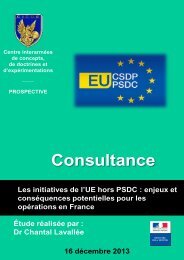Conference
science-research-bulletin-2013-conference
science-research-bulletin-2013-conference
You also want an ePaper? Increase the reach of your titles
YUMPU automatically turns print PDFs into web optimized ePapers that Google loves.
EUROPEAN POLICE SCIENCE AND RESEARCH BULLETIN<br />
SPECIAL CONFERENCE EDITION<br />
from disputes over housing to intra-ethnic rivalry<br />
(ibidem). To summarise, the results of described<br />
training are manifold: fewer offences, fewer<br />
occasions when policemen were unable to carry<br />
out relevant procedures, more offences and<br />
crimes reported by Roma themselves, and joint<br />
management (within individual competencies)<br />
of complex security events that might, were they<br />
not resolved in a timely manner, become serious<br />
crimes (Novak, 2012b).<br />
DISCUSSION<br />
In 2013, Lobnikar, Hozjan, Šuklje and Banutai<br />
(2013) conducted a survey on community<br />
policing implementation in a municipality of<br />
Lendava. Lendava was one of the places where<br />
described multi-ethnic training was conducted.<br />
The aim of the survey was to analyse the quality<br />
of police work in a multi-ethnic community in<br />
the municipality of Lendava (municipality is<br />
located in the north-eastern part of Slovenia<br />
near Murska Sobota). Policing responsibilities<br />
in Lendava are delegated to police officers from<br />
Lendava Police Station Lendava differs from other<br />
towns in Murska Sobota region in that Lendava<br />
is a more diverse multicultural environment with<br />
four autochthonous communities: Slovenes,<br />
Hungarians, Roma and Croats. This presents an<br />
even greater challenge for day to day policing<br />
and local governance. Authors hypothesised that<br />
if community policing programmes, including<br />
the described programme on policing in multiethnic<br />
environment, are effective, they should be<br />
perceived as such also by the Roma community<br />
in Lendava. In the analysis (Lobnikar et al.,<br />
2013), researchers started from substantively<br />
interdependent areas associated with the<br />
community policing paradigm: (a) quality of<br />
contact between the police and local residents,<br />
(b) the perception of the level of crime and<br />
disorder, (c) fear of victimisation, and (d) level of<br />
community cohesion.<br />
These factors are connected. The level of crime<br />
and disorder, as perceived by the population, has<br />
a direct and strong impact on the quality of life<br />
in a community. Contacts between the police<br />
and local residents are important as well. What<br />
the local residents think of the police has a direct<br />
impact on the possibility of a partner relationship<br />
between the police and the community and<br />
can influence the willingness of the population<br />
to act in conformity with the law. Fear of<br />
victimisation weakens community cohesion,<br />
which consequently loosens and annuls informal<br />
mechanisms of social control. One of the main<br />
premises of community policing is that informal<br />
control mechanisms, and not police, assure order<br />
in the neighbourhood/community. If community<br />
cohesion is weak, the community as such cannot<br />
act as a control agent. Therefore, if we seriously<br />
want to study the possibility of community<br />
policing, we also have to focus some attention<br />
on community cohesion (McKee, 2001).<br />
Data was collected among the citizens of the<br />
municipality of Lendava and members of the Roma<br />
population living in the area of the municipality<br />
(in the Roma settlement in Dolga vas and in the<br />
Lendava area). The statistical analysis included<br />
212 citizens of the municipality of Lendava, of<br />
which 51 were members of the Roma population.<br />
The results (for more see Lobnikar, Hozjan, Šuklje<br />
and Banutai, 2013) show that there are hardly<br />
any considerable differences between the local<br />
Roma and non-Roma community regarding the<br />
perception of police work in the community. In<br />
the case of the Roma community, this is a good<br />
result — the gap between the Roma community<br />
and the majority is narrowing in all areas<br />
traditionally associated with community policing:<br />
attitudes toward police, fear of being victimised,<br />
and the perception of crime and disorder. The<br />
result is important for local police organisation<br />
in particular, but in it we can also find a more<br />
generalised lesson. With planning, effort, and<br />
time, and appropriate training, policing Roma<br />
communities gives the anticipated results. In<br />
Pomurje (the north-eastern part of Slovenia) at<br />
least, police training on the Roma issue coupled<br />
with empowering projects introduced by local<br />
governments bring the Roma community out<br />
of societal margins. This lesson could be used<br />
in other parts of Slovenia, especially in the<br />
Dolenjska region, where police are facing larger<br />
problems with policing Roma communities. The<br />
lesson is simple: the police cannot do the work<br />
by themselves; support by local authorities and<br />
especially by the Roma communities, is of utmost<br />
importance.<br />
One of the finding of the survey in Lendava<br />
was also that the Roma community is not as<br />
integrated into the local community as non-<br />
Roma residents are. Sure, this discrepancy<br />
virtually cannot be directly influenced by the<br />
police as an institution, but it has an influence on<br />
the quality of the police work. We should know<br />
that one of the basic premises of community<br />
70





